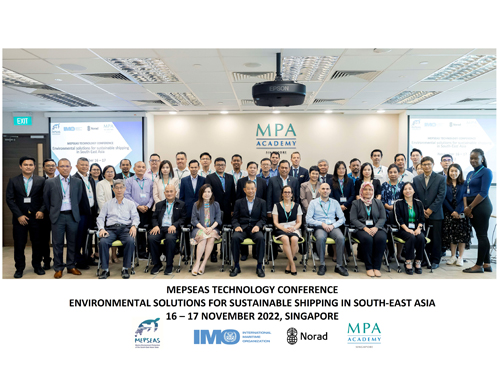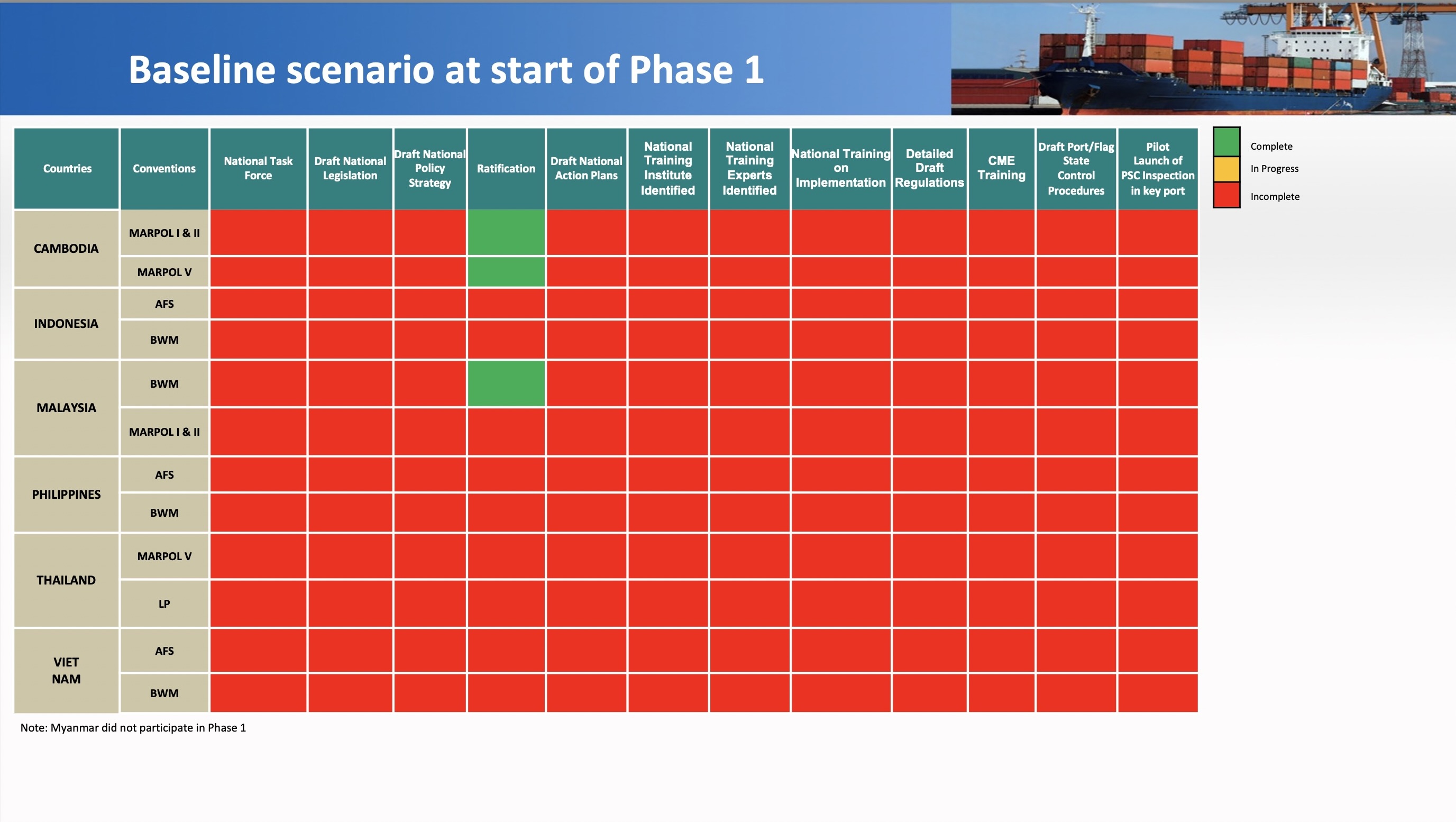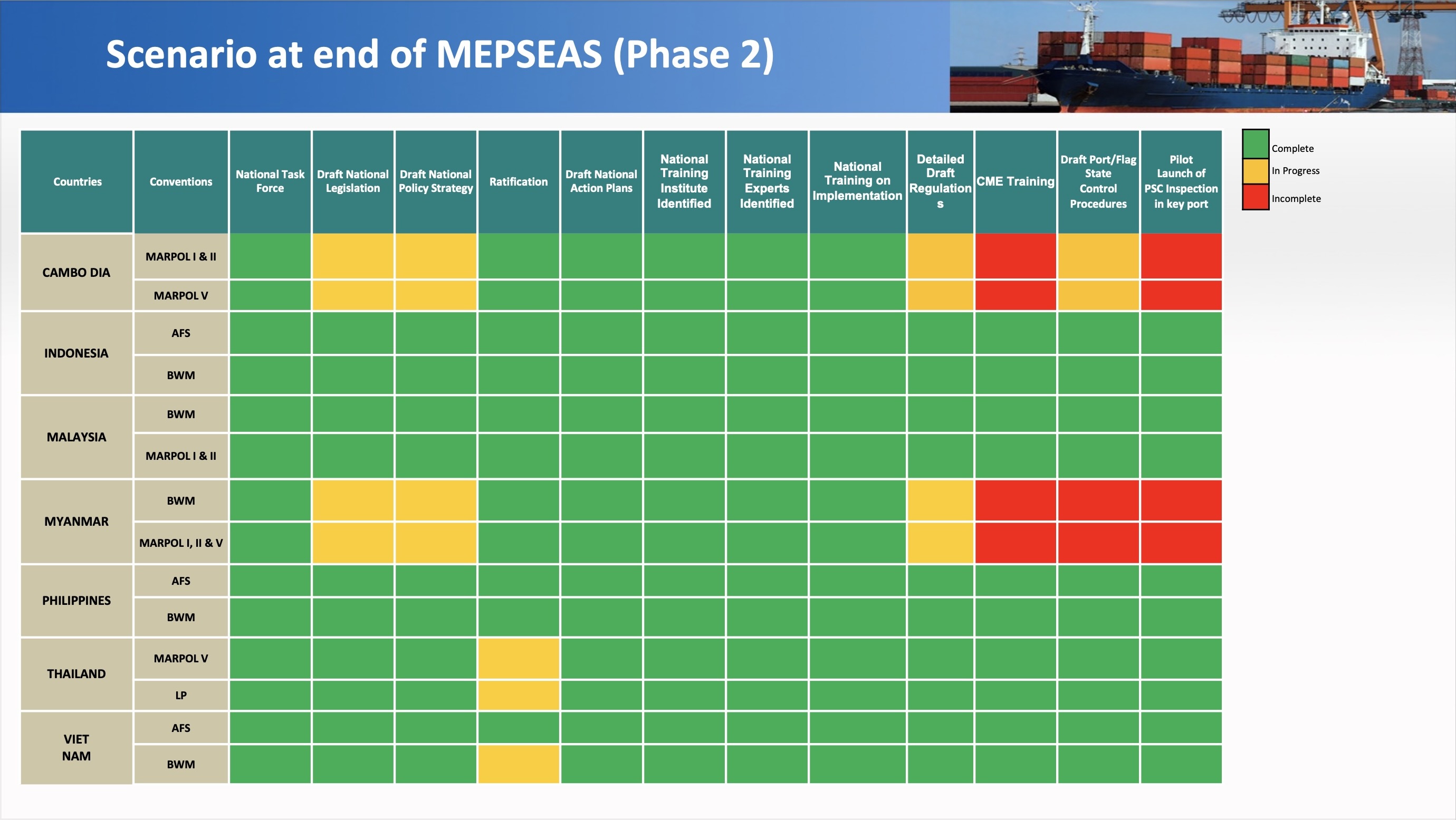Successful project to ratify and implement key marine protection treaties draws to close.

The MEPSEAS project culminated in the Technology Conference in Singapore
The conclusion of a successful five-year initiative to protect the marine environment in South-East Asia from the negative effects of ships and shipping has been marked at a high-level meeting (25-27 October) in Viet Nam with the adoption of a MEPSEAS-Halong Statement by the participating countries.
The Marine Environment Protection of the South-East Asian Seas (MEPSEAS) project has seen seven partner countries - Cambodia, Indonesia, Malaysia, Myanmar, Philippines, Thailand and Viet Nam - make substantial progress in ratifying and implementing key IMO environmental treaties. During this process, countries implemented national legal and policy developments and benefitted from related capacity building in port and flag state inspections to support enforcement of the selected Conventions. The project also supported country-specific port biological baseline survey training, the Green Shipping-Green Port-Green Shipyards (GGG) initiative of the Philippines and the holding of a regional maritime technology conference, among other activities.
As the MEPSEAS project draws to a close, Mr. Jose Matheickal, Chief, Department of Projects and Partnerships of IMO, said MEPSEAS has been one of the most successful projects IMO has handled in terms of delivery and impact on marine conservation.
"Ratification and implementation of some important IMO Conventions prioritised under this project are really going to contribute to the marine protection of the region," he said. "It was extremely pleasing to see the progress made and commitments delivered by the countries under the project. We started with a scenario where most countries have not even started the accession process and we are exiting the project when the countries have not only acceded to the Conventions, but also developed implementing legislations and practically demonstrated port state control in their ports. It was worth the journey," Mr. Matheickal added.
The MEPSEAS project was phase II of a collaboration between IMO and Norwegian Agency for Development Cooperation (NORAD) which worked in conjunction with the seven partner countries to implement the Convention on the Control of Harmful Anti-Fouling Systems in Ships (AFS), the Ballast Water Management Convention (BWM), the London Protocol and the International Convention for the Prevention of Pollution from ships (MARPOL) (particularly Annex V regulations covering garbage from ships).
The aim of MEPSEAS was that, by the end of the project, countries would have acceded and implemented their chosen Convention and have in place long-term plans to ensure the protection of the South-East Asian Seas for years to come - aims which have been achieved.
At the conclusion of the MEPSEAS Third High Level Regional Meeting in Ha Long City, Viet Nam, all participant countries adopted the Ha Long Statement which commits them to continue to work in the spirit of MEPSEAS to ratify and implement more international Conventions related to the protection of the marine environment. (Read the Ha Long Statement here.)
Mr. Matheickal highlighted what he called a "ripple effect" from the project. The model used is deemed to have been a great success, particularly the structure of regional coordination and national consultation that was built through National Task Forces, and the contribution from strategic partners such as Singapore, the Tokyo-MoU Secretariat, ASEAN, Women in Maritime-Asia and Partnerships in Environmental Management for the Seas of East Asia (PEMSEA).
The project model has motivated other regions to implement similar projects such as the Caribbean region where a project (Caribbean Sustainable Maritime Transport Project - CaribSMART) is being designed by taking the lessons from the MEPSEAS project. "The "ripple effect" of MEPSEAS is more than we had originally anticipated," said Mr Matheickal.
In fact, the Philippines have seen such merit in having a national task force as the mechanism to deal with all IMO Conventions, they have decided to formalise theirs under a new name as a permanent fixture via presidential decree.
"It looks like other countries may follow suit. Such inter-ministry mechanisms are a great legacy of the project," Mr. Matheickal said.
After the Ha Long High-Level Meeting, Mr. Jose Matheickal reflected on how IMO can harness the lessons from the MEPSEAS initiative: "How do we go forward? We ensure sustainability is integrated into project design and implementation by developing the local expertise - that contributes to sustainability beyond the project - developing the policies and legislations that will be there for ever, developing the inter-ministerial mechanisms that will be used for many countries in the future and by continuing the IMO support in sustaining the capacity building through our Integrated Technical Cooperation activities in the region."
MEPSEAS technology conference
The MEPSEAS project culminated with the MEPSEAS Technology Conference in Singapore on 16-17 November held in collaboration with the Maritime & Port Authority of Singapore. Two classification societies and IMO's Head of Marine Biosafety, Theofanis Karayannis, were also in attendance.
The event's theme was "Environmental solutions for sustainable shipping in South-East Asia" and focused on the latest technologies and solutions for ballast water management; antifouling systems and the introduction of new antifouling measures; and ship-waste management.
The conference was an opportunity to discuss the need for the development of improved ballast water technologies. There was also a chance for delegates to visit a shipyard in Singapore where they saw new ballast water technology in use. And the Philippines gave a presentation showcasing new technology being developed in their country.
MEPSEAS project
The MEPSEAS project formally comes to an end on 31 December 2022. Originally planned as a four-year programme, NORAD extended its financial assistance for a year due to the impact of Covid-19.
The Third High Level Regional Meeting in Quang Ninh was an opportunity to take stock of the overall status of MEPSEAS, and of participating countries' progress. It was also a chance for those attending - Heads of Maritime Administrations, National Focal Points, national and regional experts, and the IMO Project Coordination Unit - to reflect on the Project's key achievements and milestones.
The MEPSEAS project promoted national legal and policy developments and related capacity building in port and flag state inspections to support enforcement of the selected Conventions. And it also supported specific port biological baseline survey training, the Green Shipping-Green Port-Green Shipyards (GGG) initiative of the Philippines and the holding of a regional maritime technology conference, among other activities.
It built on the phase I IMO-Norad foundation project which saw substantial progress by countries in implementing or acceding to IMO environmental treaties. Myanmar joined the initiative at the start of phase II. For countries which have acceded to the relevant treaties in the foundation project, the MEPSEAS project has allowed them to focus on effective implementation.
How the MEPSEAS project was structured
The MEPSEAS initiative used an intervention model structured using four main pillars:
On the ground involvement. Each country had to commit in writing to deliver on the MEPSEAS aims. One important aspect was for them to appoint their own national consultants to work alongside international and regional consultants.
An easy-to-understand "traffic light" scorecard showing each participant country's progress towards ratification. IMO support was provided in the form of performance-driven interventions. Help was given to progress through the milestone stages - but moving to the next milestone was only possible once the previous one had been achieved.
High-Level Regional Meetings were held every two years to take stock and share lessons learned.
Partnerships and use of strategic partners with substantial expertise and their own network to promote and support the goals of the project.
National and regional cooperation
The seven countries were asked to choose their two highest priority IMO environmental Conventions on which they would focus.
One of the early milestones each participant country had to reach was the creation of a national taskforce. These brought together stakeholders in their countries such as Environment, Transport and Finance Ministries, and other interested parties. Most of the countries didn't have such an inter-ministerial forum to deal with marine environmental issues and some required even a presidential degree to form a mechanism of that kind.
A MEPSEAS regional high-level platform was created, and regular regional high-level meetings were held which brought together the high-level policy makers to take stock and share lessons. The project was also included as a standing agenda of the meeting of the highest level regional maritime body - the ASEAN Maritime Transport Working Group. It regularly discussed the progress of the Project and provided guidance.
A technical expert group was formed with international and regional consultants, but most work was to be done by the national consultants in each country. This enabled the building of domestic expertise to ensure the methods and ethos of MEPSEAS would be sustainable beyond the life of the project.
The seven countries involved demonstrated a spectrum of capabilities, but cooperation between them was encouraged and experience and lessons learned were shared.
Strategic partners in the region, for example, Singapore and Tokyo MOU, worked alongside other strategic partners such as Partnerships in Environmental Management for the Seas of East Asia (PEMSEA) and the Association of Southeast Asian Nations (ASEAN). The involvement of women in the project was a key aim and Women in Maritime's Asia branch (WIMA Asia) was represented in all meetings.
Creating a project brand
For phase II of the initiative, it was decided that the project should have a formal name, and the MEPSEAS brand was born.
Creating an identity and bespoke branding for the project gave it higher impact. It has inspired a similarly branded scheme, Carib-SMART, and the preparatory phase of this project is also funded by Norway.
Changing Colours: Progressing from red to green
The objective of MEPSEAS was that over the period the initiative was running, the seven countries involved would hit several pre-determined milestones before they could move on to the next stage of the process.
The milestones included the setting up of a national taskforce, drafting national legislation and a policy strategy that would enable ratification to take place. Other objectives were to put in place experts to provide training and to draft legislation and port/flag state control procedures, and to pilot the launch of port state control inspections.
In order to track the progress of the seven participating countries transparently, a score card, or dashboard, was set up using a red/yellow/green "traffic light" system to signify whether they had not yet started towards a milestone, were in progress, or had completed the task.
When the project began, most countries had yet to ratify the IMO conventions. For many, getting to that point was a highly complex process involving various stages of consultation, legislation and finally parliamentary approvals.
The score cards below show countries' progress from the start of the IMO-NOrad Phase 1 intervention to the end of MEPSEAS phase 2.


Putting in place a legal framework
One of the key elements of the initiative was to build a sustainable body of legislation-drafting expertise within the countries themselves.
Each country had its own procedures to reach the point of ratification, but they all involved complicated legal processes to get there. With the help of international experts and national consultants, MEPSEAS provided legal training in how to develop model legislation.
Workshops provided hands-on instruction which enabled the national teams to amend and enhance this for their own country-specific draft legislation.
Port State control
The final step in the MEPSEAS process was for each of the seven countries to demonstrate that they had port inspection procedures and other port state controls in place.
This milestone was considered as the end point of the MEPSEAS project intervention after journeying with the countries through the entire process of acceding to conventions through to implementing and enforcing them.
The expertise and resources of Tokyo-MoU significantly assisted with this step.






